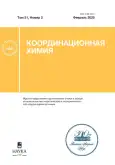Spin states of the cobalt(II) complex with bis(pyrazol-3-yl)pyridine and pH-sensitive functional groups and its deprotonated derivatives
- 作者: Safiullina E.S.1,2, Nikovskii I.A.1, Dan’shina A.A.1,3, Nelyubina Y.V.1
-
隶属关系:
- Nesmeyanov Institute of Organoelement Compounds, Russian Academy of Sciences
- Topchiev Institute of Petrochemical Synthesis, Russian Academy of Sciences
- Moscow Institute of Physics and Technology (National Research University)
- 期: 卷 51, 编号 2 (2025)
- 页面: 132-142
- 栏目: Articles
- URL: https://vestnik-pp.samgtu.ru/0132-344X/article/view/684592
- DOI: https://doi.org/10.31857/S0132344X25020065
- EDN: https://elibrary.ru/MDWHOK
- ID: 684592
如何引用文章
详细
The reaction of 2,6-bis(pyrazol-3-yl)pyridine H2L bearing pH-sensitive imino groups with cobalt perchlorate hexahydrate followed by the addition of 1,8-diazabicyclo[5.4.0]undec-7-ene affords the cobalt(II) complex [Co(H2L)2](ClO4)2 (I) and its doubly deprotonated analog [Co(HL)2]0 (II). The compounds are characterized by NMR spectroscopy, mass spectrometry, and XRD. The influence of the deprotonation of ligand H2L with a chosen base on the spin state of the cobalt(II) ion in a solution is studied by in situ NMR spectroscopy. Complex I is shown to retain its high-spin state in the whole temperature range accessible in deuterated methanol (200–325 K) both before and after the deprotonation of all pH-sensitive imino groups. However, the doubly deprotonated form of complex I (complex II–2MeOH) exists in the crystal (CIF file CCDC no. 2351546) in the low-spin state, which is the first example of the pH-induced stabilization of this state for the cobalt(II) complexes with 2,6-bis(pyrazol-3-yl)pyridines.
全文:
作者简介
E. Safiullina
Nesmeyanov Institute of Organoelement Compounds, Russian Academy of Sciences; Topchiev Institute of Petrochemical Synthesis, Russian Academy of Sciences
编辑信件的主要联系方式.
Email: fluflucat@gmail.com
俄罗斯联邦, Moscow; Moscow
I. Nikovskii
Nesmeyanov Institute of Organoelement Compounds, Russian Academy of Sciences
Email: fluflucat@gmail.com
俄罗斯联邦, Moscow
A. Dan’shina
Nesmeyanov Institute of Organoelement Compounds, Russian Academy of Sciences; Moscow Institute of Physics and Technology (National Research University)
Email: fluflucat@gmail.com
俄罗斯联邦, Moscow; Dolgoprudnyi, Moscow oblast
Yu. Nelyubina
Nesmeyanov Institute of Organoelement Compounds, Russian Academy of Sciences
Email: fluflucat@gmail.com
俄罗斯联邦, Moscow
参考
- Khusniyarov M.M. // Chem. Eur. J. 2016. V. 22. № 43. P. 15178.
- Halcrow M.A., Spin-Crossover Materials: Properties and Applications. Oxford (UK): Wiley, 2013.
- Kahn O., Kröber J., Jay C. // Adv. Mater. 1992. V. 4. № 11. P. 718.
- Kahn O., Martinez C.J. // Science 1998. V. 279. № 5347. P. 44.
- Kumar K.S., Ruben M. // Coord. Chem. Rev. 2017. V. 346. P. 176.
- Tsitovich P.B., Cox J.M., Benedict J.B., Morrow J.R. // Inorg. Chem. 2016. V. 55. № 2. P. 700.
- Jeon I.-R., Park J.G., Haney C.R. et al. // Chem. Sci. 2014. V. 5. P. 2461.
- Ohba M., Yoneda K., Agustí G. et al. // Angew. Chem. Int. Ed. 2009. V. 48. № 26. P. 4767.
- Gaudette A.I., Thorarinsdottir A.E., Harris T.D. // Chem. Commun. 2017. V. 53. № 96. P. 12962.
- Enamullah M., Linert W., Gutmann V. et al. // Monatsh. Chem. 1994. V. 125. № 12. P. 1301.
- Nowak R., Prasetyanto E.A., De Cola L. et al. // Chem. Commun. 2017. V. 53. № 5. P. 971.
- Dhers S., Mondal A., Aguilà D. et al. // J. Am. Chem. Soc. 2018. V. 140. № 26. P. 8218.
- Enamullah M., Linert W. // J. Coord. Chem. 1995. V. 35. № 3–4. P. 325.
- Seredyuk M., Znovjyak K.O., Kusz J. et al. // Dalton Trans. 2014. V. 43. № 43. P. 16387.
- Seredyuk M., Pineiro-Lopez L., Muñoz M.C. et al. // Inorg. Chem. 2015. V. 54. № 15. P. 7424.
- Luo Y.H., Nihei M., Wen G.J. et al. // Inorg. Chem. 2016. V. 55. №.16. P. 8147.
- Shiga T., Saiki R., Akiyama L. et al. // Angew. Chem. Int. Ed. 2019. V. 58. № 17. P. 5658.
- Rabelo R., Toma L., Moliner N. et al. // Chem. Sci. 2023. V. 14. № 33. P. 8850.
- Zhao J., Peng Q., Wang Z. et al. // Nat. Commun. 2019. V. 10. № 1. P. 2303.
- Halcrow M.A. // Coord. Chem. Rev. 2005. V. 249. № 25. P. 2880.
- Aleshin D.Y., Nikovskiy I., Novikov V.V. et al. // ACS omega. 2021. V. 6. № 48. P. 33111.
- Nikovskiy I.A., Polezhaev A.V., Novikov V.V. et al. // Chem. Eur. J. 2020. V. 26. P. 5629.
- Melnikova E.K., Aleshin D.Y., Nikovskiy I.A. et al. // Crystals. 2020. V. 10. № 9. P. 793.
- Nikovskiy I.А., Polezhaev A.V., Novikov V.V. et al. // Crystals. 2021. V. 11. № 8. P. 922.
- Pankratova Y., Aleshin D., Nikovskiy I. et al. //Inorg. Chem. 2020. V. 59. № 11. P. 7700.
- Roebuck J.W., Bailey P.J., Doidge E.D. et al. // Solvent Extr. Ion Exch. 2018. V. 36. № 5. P. 437.
- Korzekwa J., Scheurer A., Heinemann F. W. et al. //Dalton Trans. 2017. V. 46. № 40. P. 13811.
- Creutz S.E., Peters J.C. // Inorg. Chem. 2016. V. 55. № 8. P. 3894.
- Sheldrick G.M. // Acta Crystallogr. A. 2008. V. 64. P. 112.
- Dolomanov O.V., Bourhis L.J., Gildea R.J. et al. // J. Appl. Cryst. 2009. V. 42. P. 339.
- Rossini E., Bochevarov A.D., Knapp E.W. // ACS omega. 2018. V. 3. № 2. P. 1653.
- Weber B., Walker F.A. // Inorg. chem. 2007. V. 46. № 16. P. 6794.
- Pavlov A.A., Denisov G.L., Kiskin M.A. et al. // Inorg. Chem. 2017. V. 56. № 24. P. 14759.
- Alvarez S. // Chem. Rev. 2015. V. 115. № 24. P. 13447.
- Rodriguez-Jimenez S., Brooker S. // Inorg. Chem. 2017. V. 56. № 22. P. 13697.
- Klaeui W., Eberspach W., Guetlich P. / Inorg. Chem. 1987. V. 26. № 24. P. 3977.
- Cook B.J., Polezhaev A.V., Chen C.H. et al. // Eur. J. Inorg. Chem. 2017. V. 2017. № 34. P. 3999.
补充文件
















